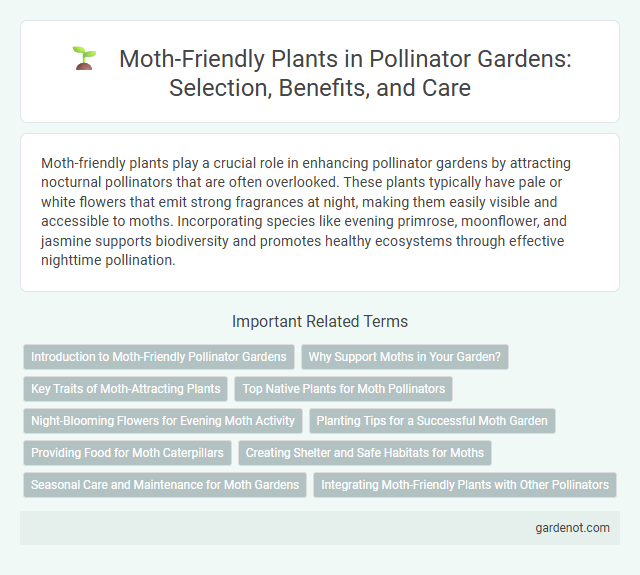Moth-friendly plants play a crucial role in enhancing pollinator gardens by attracting nocturnal pollinators that are often overlooked. These plants typically have pale or white flowers that emit strong fragrances at night, making them easily visible and accessible to moths. Incorporating species like evening primrose, moonflower, and jasmine supports biodiversity and promotes healthy ecosystems through effective nighttime pollination.
Introduction to Moth-Friendly Pollinator Gardens
Moth-friendly pollinator gardens emphasize night-blooming plants that attract and support moth species, essential nocturnal pollinators. Incorporating native flowering plants such as evening primrose, moonflower, and jasmine provides nectar sources and habitat for diverse moth populations. These gardens contribute to biodiversity by sustaining moths, which play a crucial role in pollinating night-blooming flora and maintaining healthy ecosystems.
Why Support Moths in Your Garden?
Supporting moths in your pollinator garden enhances nighttime pollination, promoting biodiversity and healthier ecosystems. Moth-friendly plants such as evening primrose, honeysuckle, and jasmine provide vital nectar sources that sustain moth populations and encourage their reproductive cycles. Cultivating these plants helps maintain balanced pollinator communities, ensuring continuous pollination services beyond daylight hours.
Key Traits of Moth-Attracting Plants
Moth-attracting plants typically have pale or white flowers that reflect moonlight, making them visible during nighttime pollination. These blooms often emit strong, sweet fragrances in the evening to lure moths from a distance. Nectar-rich flowers with tubular shapes accommodate the long proboscises of various moth species, enhancing pollination efficiency.
Top Native Plants for Moth Pollinators
Top native plants for moth pollinators include evening primrose, moonflower, and wild tobacco, which provide essential nectar sources during nighttime hours. These species attract diverse moth populations by offering fragrant blooms and ample nectar, supporting moth life cycles and promoting biodiversity in pollinator gardens. Incorporating native plants like phlox and jewelweed enhances habitat quality, ensuring sustainable food sources for local moth species.
Night-Blooming Flowers for Evening Moth Activity
Night-blooming flowers such as evening primrose, moonflower, and night-scented stock are essential for supporting evening moth activity in pollinator gardens. These plants emit strong fragrances and produce nectar during nighttime hours, attracting moths like hawk moths and sphinx moths. Incorporating a variety of nocturnal blossoms enhances biodiversity and ensures pollination continuity after sunset.
Planting Tips for a Successful Moth Garden
Select native, night-blooming flowers such as evening primrose and jasmine to attract moths, ensuring plants bloom during peak moth activity in late spring and summer. Provide sheltered areas with dense foliage to protect moths from wind and predators, enhancing their habitat and encouraging pollination. Avoid pesticides and use organic compost to maintain soil health, promoting vibrant blooms that support diverse moth populations throughout the growing season.
Providing Food for Moth Caterpillars
Moth-friendly plants such as willow, oak, and cherry trees provide essential food sources for moth caterpillars, supporting their growth and development. Native wildflowers like jewelweed and milkweed offer supplementary nourishment that attracts diverse moth species. Incorporating these plants into a pollinator garden enhances biodiversity by sustaining moth populations from larval to adult stages.
Creating Shelter and Safe Habitats for Moths
Moth-friendly plants such as native evening primrose and jasmine provide essential shelter and safe habitats for moths by offering dense foliage and nighttime nectar sources. Incorporating these plants into a pollinator garden creates microhabitats that protect moths from predators and harsh weather conditions. Prioritizing diverse plant structures enhances moth survival and supports their role in pollination ecosystems.
Seasonal Care and Maintenance for Moth Gardens
Moth-friendly plants in pollinator gardens require seasonal care that includes regular watering during dry periods and pruning after flowering to promote healthy growth. Mulching helps retain soil moisture and regulates temperature, supporting larval host plants crucial for moth development. Monitoring for pests and diseases ensures plants remain vibrant, providing essential nectar sources for nocturnal moth species throughout their active seasons.
Integrating Moth-Friendly Plants with Other Pollinators
Integrating moth-friendly plants such as evening primrose and night-blooming jasmine with pollinator-attracting species like milkweed and coneflowers enhances garden biodiversity and supports a wider range of pollinators including bees, butterflies, and hummingbirds. These plants provide nectar sources during dusk and nighttime, ensuring continuous food supply and habitat diversity. Creating a layered garden structure with varying bloom times maximizes pollination potential and ecosystem resilience.
Moth-friendly plant Infographic

 gardenot.com
gardenot.com